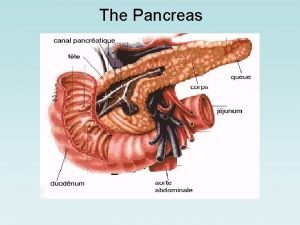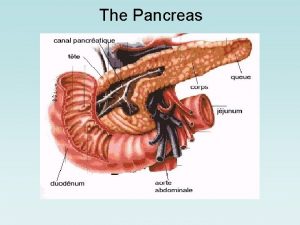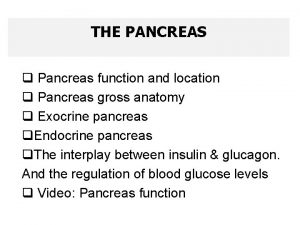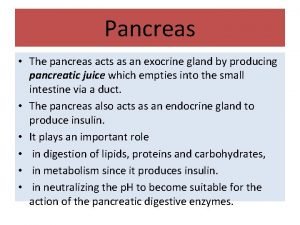Pancreas Introduction to the Pancreas The pancreas is



















- Slides: 19

Pancreas

Introduction to the Pancreas • The pancreas is a large gland located in the upper left abdomen behind the stomach, as shown in the figure below. • The pancreas is about 15 centimetres (6 in. ) long; and it has a flat, oblong shape. Structurally, the pancreas is divided into a head, body, and tail. • Functionally, the pancreas serves as both an endocrine gland an exocrine gland.

Pancreas The pancreas is located behind the stomach and near the upper part of the small intestine (duodenum). Its ducts carry digestive enzymes into the small intestine. The endocrine hormones it produces are secreted into the blood. (By Blausen gallery 2014". Wikiversity Journal of Medicine. DOI: 10. 15347/wjm/2014. 010. ISSN 20018762. [CC BY 3. 0 via Wikimedia Commons)

• As an endocrine gland, the pancreas is part of the endocrine system. As such, it releases hormones, such as insulin, directly into the bloodstream for transport to cells throughout the body. Pancreas • As an exocrine gland, the pancreas is part of the digestive system. As such, it releases digestive enzymes into ducts that carry the enzymes to the gastrointestinal tract where they assist with digestion. In this concept, the focus is on the pancreas as an endocrine gland. You can read about the pancreas as an exocrine gland in the chapter Digestive System.

The Pancreas as an Endocrine Gland • The tissues within the pancreas that have an endocrine role exist as clusters of cells called pancreatic islets. They are also called the islets of Langerhans. • You can see pancreatic tissue, including islets, in the figure on next slide. There approximately 3 million pancreatic islets, and they are crisscrossed by a dense network of capillaries. • The capillaries are lined by layers of islet cells that have direct contact with the blood vessels, into which they secrete their endocrine hormones.

The Pancreas as an Endocrine Gland • This figure shows the anatomy of the pancreas. The inset diagram in the figure shows pancreatic islet cells that produce endocrine hormones. It also shows the cells (called acinar cells) that secrete exocrine substances involved in digestion into pancreatic ducts. (By Open. Stax College [CC BY 3. 0 via Wikimedia Commons).

• The pancreatic islets consist of four main types of cells, each of which secretes a different endocrine hormone. However, all of the hormones produced by the pancreatic islets play crucial roles in glucose metabolism and the regulation of blood glucose levels, among other functions. The Pancreas as an Endocrine Gland • Islet cells called alpha (α) cells secrete the hormone glucagon. The function of glucagon is to increase the level of glucose in the blood. It does this by stimulating the liver to convert stored glycogen into glucose, which is released into the bloodstream. • Islets cells called beta (β) cells secrete the hormone insulin. The function of insulin is to decrease the level of glucose in the blood. It does this by promoting the absorption of glucose from the blood into fat, liver, and skeletal muscle cells. In these tissues, the absorbed glucose is converted into glycogen, fats (triglycerides), or both. • Islet cells called delta (δ) cells secrete the hormone somatostatin. This hormone is also called growth hormone inhibiting hormone because it inhibits the anterior lobe of the pituitary gland from producing growth hormone. Somatostatin also inhibits the secretion of pancreatic endocrine hormones and pancreatic exocrine enzymes. • Islet cells called gamma (γ) cells secrete the hormone pancreatic polypeptide. The function of pancreatic polypeptide is to help regulate the secretion of both endocrine and exocrine substances by the pancreas.

Disorders of the Pancreas • There a variety of disorders that affect the pancreas. They include pancreatitis, pancreatic cancer, and diabetes mellitus.

• Pancreatitis is inflammation of the pancreas. It has a variety of possible causes including gallstones, chronic alcohol use, infections such as measles or mumps, and certain medications. Pancreatitis occurs when digestive enzymes produced by the pancreas damage the gland’s tissues, which causes problems with fat digestion. Pancreatitis • The disorder is usually associated with intense pain in the central abdomen, and the pain may radiate to the back. Yellowing of the skin and whites of the eyes (see image next slide)which is called jaundice, is a common sign of pancreatitis. • People with pancreatitis may also have pale stools and dark urine. Treatment of pancreatitis includes administering drugs to manage pain and addressing the underlying cause of the disease, for example, by removing gallstones.

Pancreatitis Jaundice, or yellowing of the skin and whites of the eyes, is a common sign of pancreatitis. (Public domain; CDC/Dr. Thomas F. Sellers/Emory University via Wikimedia Commons).

Pancreatic Cancer • There are several different types of pancreatic cancer that may affect either the endocrine or the exocrine tissues of the gland. Cancers affecting the endocrine tissues are all relatively rare. However, their incidence has been rising sharply. It is unclear to what extent this reflects increased detection, especially through medical imaging techniques. Unfortunately, pancreatic cancer is usually diagnosed at a relatively late stage when it is too late for surgery, which is the only way to cure the disorder. In the United States, pancreatic cancer is the fourth most common cause of deaths due to cancer. • Pancreatic cancer is rare before the age of 40 and occurs most often after the age of 60. Factors that increase the risk of developing pancreatic cancer include smoking, chronic pancreatitis, and diabetes. About one in four cases of pancreatic cancer are attributable to smoking. Certain rare genetic conditions are also risk factors for pancreatic cancer.

• By far the most common type of pancreatic disorder is diabetes mellitus, more commonly called simply diabetes. There are many different types of diabetes, but diabetes mellitus is the most common. Diabetes Mellitus • It occurs in two major types, type 1 diabetes and type 2 diabetes. The two types have different causes and may also have different treatments, but they generally produce the same initial symptoms, which include excessive urination and thirst. • These symptoms occur because the kidneys excrete more urine in an attempt to rid the blood of excess glucose, and loss of water in urine stimulates greater thirst.

Other signs and symptoms of diabetes are listed in the image This chart shows symptoms shared by both type 1 and type 2 diabetes in black and symptoms more common in type 1 diabetes in blue. (By Mikael Häggström [Public domain], via Wikimedia Commons).

Diabetes Mellitus • When diabetes is not well controlled, it is likely to have several serious long-term consequences. Most of these consequences are due to damage to small blood vessels because of high blood levels of glucose. Damage to blood vessels, in turn, may lead to increased risk of coronary artery disease and stroke. Damage to blood vessels in the retina of the eye can result in gradual vision loss and blindness. • Damage to blood vessels in the kidneys can lead to chronic kidney disease, sometimes requiring dialysis or kidney transplant. Long-term consequences of diabetes may also include damage to the nerves of the body, known as diabetic neuropathy. • In fact, this is the most common complication of diabetes. Symptoms of diabetic neuropathy may include numbness, tingling, and pain in the extremities.

• Type 1 diabetes is a chronic autoimmune disorder in which the immune system attacks the insulin-secreting beta cells of the pancreas. Type 1 Diabetes • As a result, people with type 1 diabetes lack the insulin needed to keep blood glucose levels within the normal range. • Type 1 diabetes may develop in people of any age but is most often diagnosed before adulthood. • For type 1 diabetics, insulin injections are critical for survival.

Type 2 Diabetes • Type 2 diabetes is the single most common form of diabetes. The cause of high blood glucose in this form of diabetes usually includes a combination of insulin resistance and impaired insulin secretion. • Both genetic and environmental factors play roles in the development of type 2 diabetes. • Management of type 2 diabetes includes changes in diet and physical activity, which may increase insulin sensitivity and help reduce blood glucose levels to normal ranges. • Medications may also be used as part of the treatment, as may insulin injections.

• The pancreas is a gland located in the upper left abdomen behind the stomach that functions as both an endocrine gland an exocrine gland. As an endocrine gland, the pancreas releases hormones, such as insulin, directly into the bloodstream. As an exocrine gland, the pancreas releases digestive enzymes into ducts that carry them to the gastrointestinal tract. Summary • Tissues in the pancreas that have an endocrine role exist as clusters of cells called pancreatic islets. The islets consist of four main types of cells, each of which secretes a different endocrine hormone. Alpha (α) cells secrete glucagon, beta (β) cells secrete insulin, delta (δ) cells secrete somatostatin, and gamma (γ) cells secrete pancreatic polypeptide. • The endocrine hormones secreted by the pancreatic islets all play a role, either directly or indirectly, in glucose metabolism and homeostasis of blood glucose levels. For example, insulin stimulates the uptake of glucose by cells and decreases the level of glucose in the blood, whereas glucagon stimulates the conversion of glycogen to glucose and increases the level of glucose in the blood.

• Disorders of the pancreas include pancreatitis, pancreatic cancer, and diabetes mellitus. Pancreatitis is a painful inflammation of the pancreas that has many possible causes. Pancreatic cancer of the endocrine tissues is rare but increasing in frequency. It is generally discovered too late to cure surgically. Smoking is a major risk factor for pancreatic cancer. Summary • Diabetes mellitus is the most common type of pancreatic disorder. In diabetes, inadequate activity of insulin results in high blood levels of glucose. Type 1 diabetes is a chronic autoimmune disorder in which the immune system attacks the insulin-secreting beta cells of the pancreas. Type 2 diabetes is usually caused by a combination of insulin resistance and impaired insulin secretion due to a variety of environmental and genetic factors.

The End
 Hình ảnh bộ gõ cơ thể búng tay
Hình ảnh bộ gõ cơ thể búng tay Bổ thể
Bổ thể Tỉ lệ cơ thể trẻ em
Tỉ lệ cơ thể trẻ em Chó sói
Chó sói Tư thế worm breton là gì
Tư thế worm breton là gì Chúa sống lại
Chúa sống lại Kể tên các môn thể thao
Kể tên các môn thể thao Thế nào là hệ số cao nhất
Thế nào là hệ số cao nhất Các châu lục và đại dương trên thế giới
Các châu lục và đại dương trên thế giới Công thức tiính động năng
Công thức tiính động năng Trời xanh đây là của chúng ta thể thơ
Trời xanh đây là của chúng ta thể thơ Cách giải mật thư tọa độ
Cách giải mật thư tọa độ Làm thế nào để 102-1=99
Làm thế nào để 102-1=99 độ dài liên kết
độ dài liên kết Các châu lục và đại dương trên thế giới
Các châu lục và đại dương trên thế giới Thể thơ truyền thống
Thể thơ truyền thống Quá trình desamine hóa có thể tạo ra
Quá trình desamine hóa có thể tạo ra Một số thể thơ truyền thống
Một số thể thơ truyền thống Cái miệng nó xinh thế
Cái miệng nó xinh thế




































